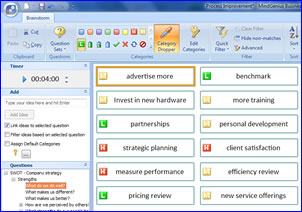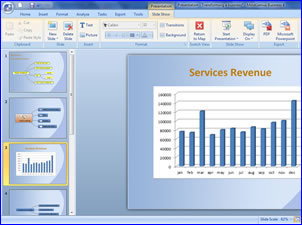 MindGenius 4 was launched a few days ago, with major improvements in brainstorming, presentations, project management and task management. These updates strengthen its utility as a business tool, and should make it more attractive to organizations of all sizes. Here are two of the most significant new and improved features in MindGenius 4, and my first impressions of them, based on a peek at the new version.
MindGenius 4 was launched a few days ago, with major improvements in brainstorming, presentations, project management and task management. These updates strengthen its utility as a business tool, and should make it more attractive to organizations of all sizes. Here are two of the most significant new and improved features in MindGenius 4, and my first impressions of them, based on a peek at the new version.
Brainstorming mode
This new ideation tool (pictured above right – click to view bigger version) opens in a new window. You enter your ideas in a panel on the left side of the workspace. As you add ideas, they are displayed in a grid of rectangular boxes, which make efficient use of screen real estate and enable you to easily see all of your ideas. This is important, because during brainstorming sessions, one idea may serve as a stepping stone to another. The focus in brainstorming mode is on entering ideas quickly, without regard to their structure. You can use some built-in question sets to help facilitate your next group brainstorming session, or create and save your own, which you can re-use on future projects – nice!
The left-hand panel of the brainstorming view also contains a countdown timer, useful for those team meetings where you want to set a time limit on idea generation. It also contains a panel of questions that you can use as catalysts to spur creative ideas. It initially displays the “5 Ws and H” – who, what, when, where, why and how, with multiple questions under each heading.Clicking on the “question sets” button in the brainstorming window’s toolbar reveals 20 sets of business-oriented questions, covering everything from failure mode analysis, marketing and decision making to project planning and meeting management. Clearly, a lot of work went into the creation of these business-focused questions.
From the drop-down list of questions, you can access an “add/edit question sets” command, which opens a second window with a simple two-panel interface where you can create your own list of questions from scratch, based upon an existing question set or edit an existing one. This is potentially very powerful, in my opinion, because you can create a standardized set of brainstorming questions that everyone on your team can use.
Also, by clicking on a button within this side panel, you can customize the categories to which you will assign your ideas. The category management dialog box is well designed, with categories divided into “brainstorming,” “impact,” “difficulty” and “review.” To edit a category, you simply select it and click the “rename” button. You can also add and delete categories at will. As an experienced brainstormer, I’m thrilled to see that MindGenius included “impact” and “difficulty” in the list of categories. Why? Because they are two key criteria that are typically used to evaluate ideas. If your organization uses other criteria, such as cost or ease of implementation, you can easily create new category groups and create values that you can use to evaluate ideas in MindGenius 4. In addition, you can right-click on any category you have created and add it to “my categories” – so it can be used in other mind maps. I love this level of flexibility and customization!
Once you’re happy with your categories and groups, you can then assign them to specific ideas, using a group of colored icons in the toolbar. Click the category you want to add, and a small icon corresponding to that category is added to the idea. One really nice touch is that when you hover over one of these icons, either in the program’s toolbar or next to an idea, a tooltip pops up to remind you what that icon means. That saved me a lot of confusion as I was playing around with this part of MindGenius 4. Kudos to the developers for paying such close attention to usability!
The final step in brainstorming mode is to create a mind map from the ideas you have gathered. MindGenius 4 gives you three options:
- Create an unstructured map
- Create a category-centric map
- Create a question-centric map
Selecting the first option creates a traditional mind map with each of your ideas formatted as a separate child topic, still displaying the icons you assigned to them. Selecting the second option creates a map with an org chart type of layout, with your ideas neatly added to the proper categories.The question-centric map displays a right-facing mind map, with a progression from your brainstorm name, to the question and the ideas that resulted from it, from left to right. This gives you a nice “roadmap” to document where each idea came from. Nicely done!
While it’s not unusual for mind mapping software to have a brainstorming mode, the depth of capabilities and customization offered in MindGenius 4’s brainstorming mode is simply astounding. If your job involves generating, organizing and evaluating ideas, then you’ll want to have this tool on your computer – because it will greatly simplify your life!
Presentation mode
 Like a number of mind mapping softtware programs, the developers of MindGenius have adopted the slide show presentation model in version 4. In other words, you select one or more topics from your mind map, and then tell the program to add a “snapshot” containing those branches and sub-branches into a slide in your presentation (see image at right; click to view larger version).
Like a number of mind mapping softtware programs, the developers of MindGenius have adopted the slide show presentation model in version 4. In other words, you select one or more topics from your mind map, and then tell the program to add a “snapshot” containing those branches and sub-branches into a slide in your presentation (see image at right; click to view larger version).
MindGenius has done a fine job of implementing this new mode. When you select a branch and add it to your presentation, it appears not only in a vertical panel on the left side of the screen – a la PowerPoint – but also in the main workspace. In other words, the map view changes to show the topics and subtopics you have selected for that slide. From this view, you can easily zoom in and out and pan up and down and side to side, to position your topics exactly as you want them to appear in your presentation.
These positioning tweaks are more important than you might think, because you can actually add text (a slide title, for example) and images to your slides from within this view. In addition, you can add a background to your slides (choosing from a nicely designed set of patterns included with the program or use your own image file) to give them a professional look. You can also apply transitions to slides. Clearly the developers at MindGenius saw an opportunity to rethink the whole concept of what a mind mapping presentation view could do, because they’ve definitely kicked it up a few notches over anything I’ve seen before!
When you’re done manipulating your slide, a “return to map” button in the program’s toolbar returns you to the main map view. If you want to quickly convert a set of child topics into separate slides, one per topic, that’s also fairly easy to do. MindGenius treats each of the sibling topics as its own slide, and can even do so without switching to the presentation view – a real time saver. Finally, as you would expect, you can edit or annotate map branches in your slides during your presentation – which can make for a very interactive experience during your next meeting!
Learn more about MindGenius 4
There is much more to MindGenius 4, which you can learn about at the program’s new product page.
Conclusion
I’m very impressed with the progress that the developers have made in the new brainstorming and presentation capabilites of MindGenius 4. I’m a stickler for intelligent, intuitive interface design, and I’m happy to report that both of the new views are winners in my book. I also don’t like it when developers pile on new features just for the sake of doing so. Ideally, new features ought to hep users to be more productive or creative. Again, MindGenius 4 excels on all counts. It’s an ideal program for capturing, organizing, evaluating and presenting your business ideas!
A 30-day trial version of MindGenius 4 is available from the developer’s website.

Leave a Reply